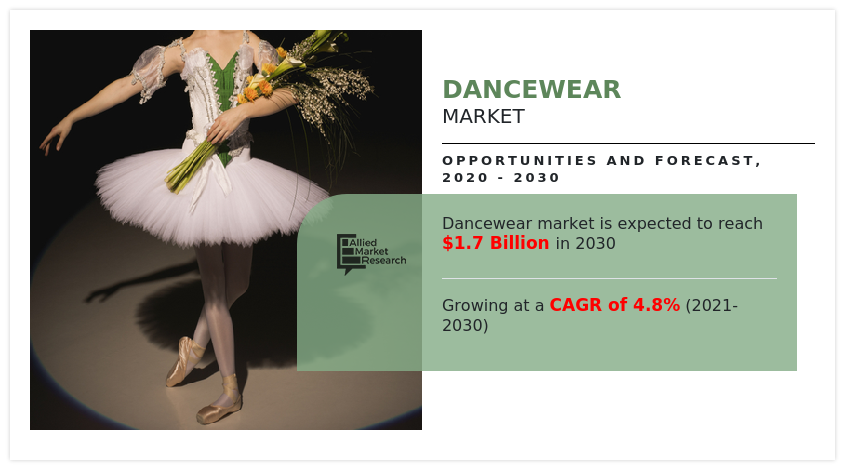According to a new report published by Allied Market Research, titled, “Dancewear Market,” The dancewear market size was valued at $1.1 billion in 2020, and is estimated to reach $1.7 billion by 2030, growing at a CAGR of 4.8% from 2021 to 2030. Dancewear is a type of clothing and footwear that comes in a variety of colors, fabrics, materials, sizes, and designs that are suitable for a certain range of dance genres. It is designed to suit aesthetic requirements while also increasing involvement in the dance is performed.
Request For Sample :- https://www.alliedmarketresearch.com/request-sample/7188
It has grown in popularity not just among mainstream superstars performing at events but also for dance schools, fitness studios, and Zumba classes. Dancewear is no longer restricted to old-fashioned garments worn just for dancing, it has been launched in athletic style, body fit designs, and enhanced textiles that may be worn for exercising and yoga activities. The dancewear industry has grown extremely competitive as many important companies are eager to introduce new trends, and fashion design start-ups are investing in dancewear in a variety of colors and styles. The availability of dancewear in a variety of vibrant colors, printed designs, geometric designs, increased fabric flexibility &comfort, ballet dancewear, customization of costumes, similar designs to those worn by mainstream dancers, and the availability of several artist collections have all contributed to the development of new dancewear market trends. Leading businesses are spending more on sustainable processes and higher quality dancewear. For instance, Zarely, a dancewear business, created a range of geometric patterns, asymmetric tops, a combination of classic & modern dancewear, and athleisure wear that can be worn as dancewear and any other occasion. The availability of high quality dancewear products is expected the fuel the dancewear market demand.
However, the availability of counterfeit products affects the overall apparel industry and dancewear market growth. Counterfeits might lead to governments refusing to spend for fear of losing product protection. Moreover, they have a significant influence on companies since premium brands acquire their distinction from their reputation as well as the restricted amount accessible. Counterfeits contaminate the supply with similar-looking items of lesser quality and are not created with the same attention. Businesses suffer from a lack of IPR (Intellectual Property Rights) protection in more ways than one. It is not only a direct loss of income but also a loss of brand image. The use of a brand’s trademark attracts consumers to come and purchase the product at a very low price, as individuals are able to acquire the product that costs 5 to 10 times more in the market. A trademark is a company’s most precious asset, and counterfeit items take advantage of it. As a result, the growth of the dancewear sector is declining, and it may only revive if the government prohibits the sale of counterfeit goods.
Procure Complete Report (245 Pages PDF with Insights, Charts, Tables, and Figures) @checkout link :- https://www.alliedmarketresearch.com/checkout-final/3045a71570ba3697e35b184f56801045
The global dancewear market is segmented into product type, application, end user, distribution channel, and region. On the basis of type, the market is categorized into bodywear, footwear, and accessories. By application, it is segregated into theatres, concerts, entertainment Industry, and others. As per end user, it is fragmented into men, women and children. Depending on distribution channel, it is differentiated into specialty stores, online channels, hypermarkets/supermarkets, and others. Region wise, it is analyzed across North America (the U.S., Canada, and Mexico), Europe (Germany, the UK, France, Italy, Spain, and rest of Europe), Asia-Pacific (China, Japan, India, Australia, South Korea, and rest of Asia-Pacific), and LAMEA (Brazil, Argentina, Saudi Arabia, South Africa, and rest of LAMEA).
Key findings of the study
· On the basis of type, the bodywear segment is projected to witness the highest CAGR of 4.0%, in revenue terms, during the forecast period.
· By application, the others segment is expected to dominate the market from 2021 to 2030.
· Depending on end user, the women segment is projected to witness the highest share, in revenue terms, during the forecast period.
· As per distribution channel, the online channels segment is expected to grow at a significant CAGR during the forecast period.
· U.S. was the largest country, in terms of revenue generation for the dancewear market in 2020.
· Asia-Pacific is anticipated to witness the highest growth rate, registering a CAGR of 6.1% from 2021 to 2030.
Players operating in the global dancewear market have adopted various developmental strategies to expand their dancewear market share, increase profitability, and remain competitive in the market. The key players profiled in this report include Ballet Makers, Inc, Bloch International, Bullet Pointe, LLC, Flo Dancewear Pty. Ltd, Grishko Dance S.R.O, Onward Holdings Co., Ltd., Provins Business Co. Ltd., Revolution Dancewear, LLC, SF DancegearWaterloo, and Wearmoi Dancewear.
Enquire before buying @purchase enquire link :- https://www.alliedmarketresearch.com/purchase-enquiry/7188
Similar Reports :-
Intimate Wear Market https://www.alliedmarketresearch.com/intimate-wear-market
Footwear Market https://www.alliedmarketresearch.com/footwear-market
David Correa
Allied Analytics LLP
+ + +1 503-894-6022
email us here
Visit us on social media:
Facebook
Twitter
LinkedIn
